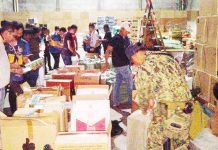
SECURITY is a relative term, and how it is understood would depend on who are the powers that would define it.
Take the case of food security for instance. On one hand, a few months supply of rice could already considered as sufficient, as the government would define it. On the other hand, others would say that it should really be a few years supply to make it truly secure, but that would of course depend on our capability to store it for long periods, assuming that we could produce it in the first place.
As far as I am concerned, any food supply such as rice that is imported at least 50 percent could hardly be considered as secure.
In my book, the key word in food security is production, meaning that we need to produce at least 50 percent of a commodity in order to be secure. Importation is of course an option, but that could hardly be considered as being secure, especially if we have to compete with other countries in order to buy what we need.
Besides, importation is a two-step process that would need the use of foreign exchange. It will reduce our dollar reserves, yet another security issue. On the other hand, production could lead to additional export revenues, which would increase our dollar reserves.
Production is just one issue in food security, because distribution is also another major issue, starting with storage. It is a well-known fact that there are many food crops that are produced in Mindanao for instance that could not be transported economically to Visayas and Luzon, much less stored. In other words, we may have the food supplies that we need, and yet we are unable to bring these to the markets where they are needed, at fair prices that are still competitive with their imported substitutes.
Food security is a supply chain issue, and when we deal with the issue, we should deal with the entire chain, and not just parts of it. Even if the production side could be strengthened, we should also strengthen the distribution side.
Others may argue that storage is still on the production side, but I say that it is actually the starting point of the distribution side. Definitely, sorting, sizing, grading, milling and packing are still on the production side, but as soon as a product is packed, it should already enter the distribution stage.
What is being done by the majority over long periods of time is not necessarily the right thing to do. This observation could be true when it comes to the way that we pack, store and distribute rice. Ever since, and as far back as we could all remember, rice has always been packed, stored and distributed in sacks. In many other countries, all types of grains and beans are stored in silos, and are distributed in large containers.
Here in the Philippines, we hardly have silos, and that is the reason why our spoilage is very high, because the rice sacks are vulnerable to insects, vermin, moisture and floods.
Our present land reform program has obviously not adopted the supply chain approach, and that is why the livelihood of the beneficiaries has not improved since the program was started. It is not enough to give them land, even if you give them irrigation and fertilizers too. Even if the farmers could produce, they still need the storage facilities so that the spoilage will be reduced, and so that they could wait for the best prices until it is time for them to sell. However, the bigger problem really is that they lack the professional farm management skills that are needed in order to increase their production.
For many years now, most farmers would say that their problems are financing, irrigation and farm to market roads. Agriculturist Patrick Pineda disagrees, and he says that their problem is the lack of professional farm management, period. He says that the average age of Filipino farmers is 60 years old, and most of them could not produce more than 60 cavans per hectare.
He adds that we could fight hunger and poverty with a few old farmers, and that is why he is advocating that we mobilize a younger army of professional farmers who could produce more./PN





